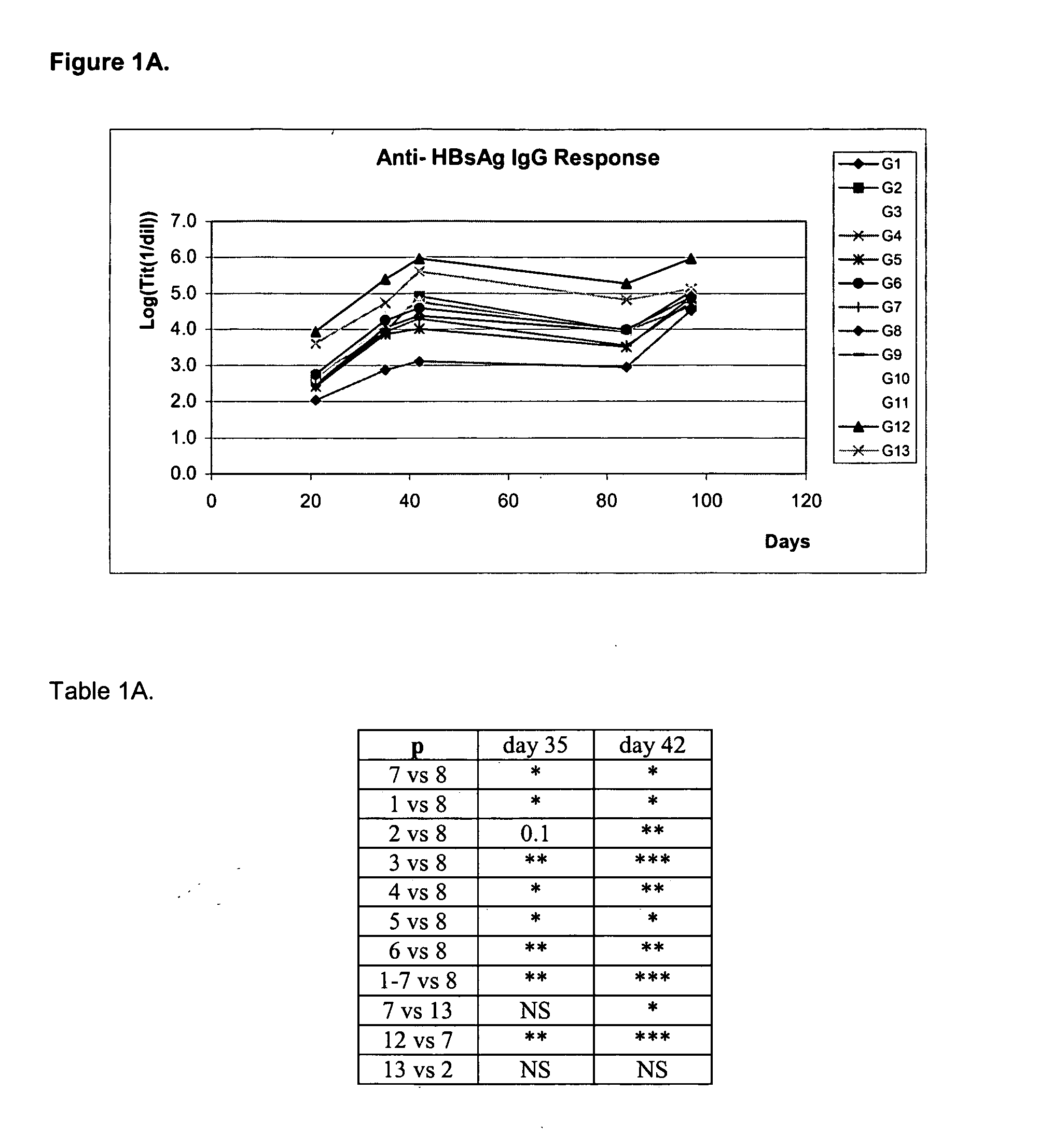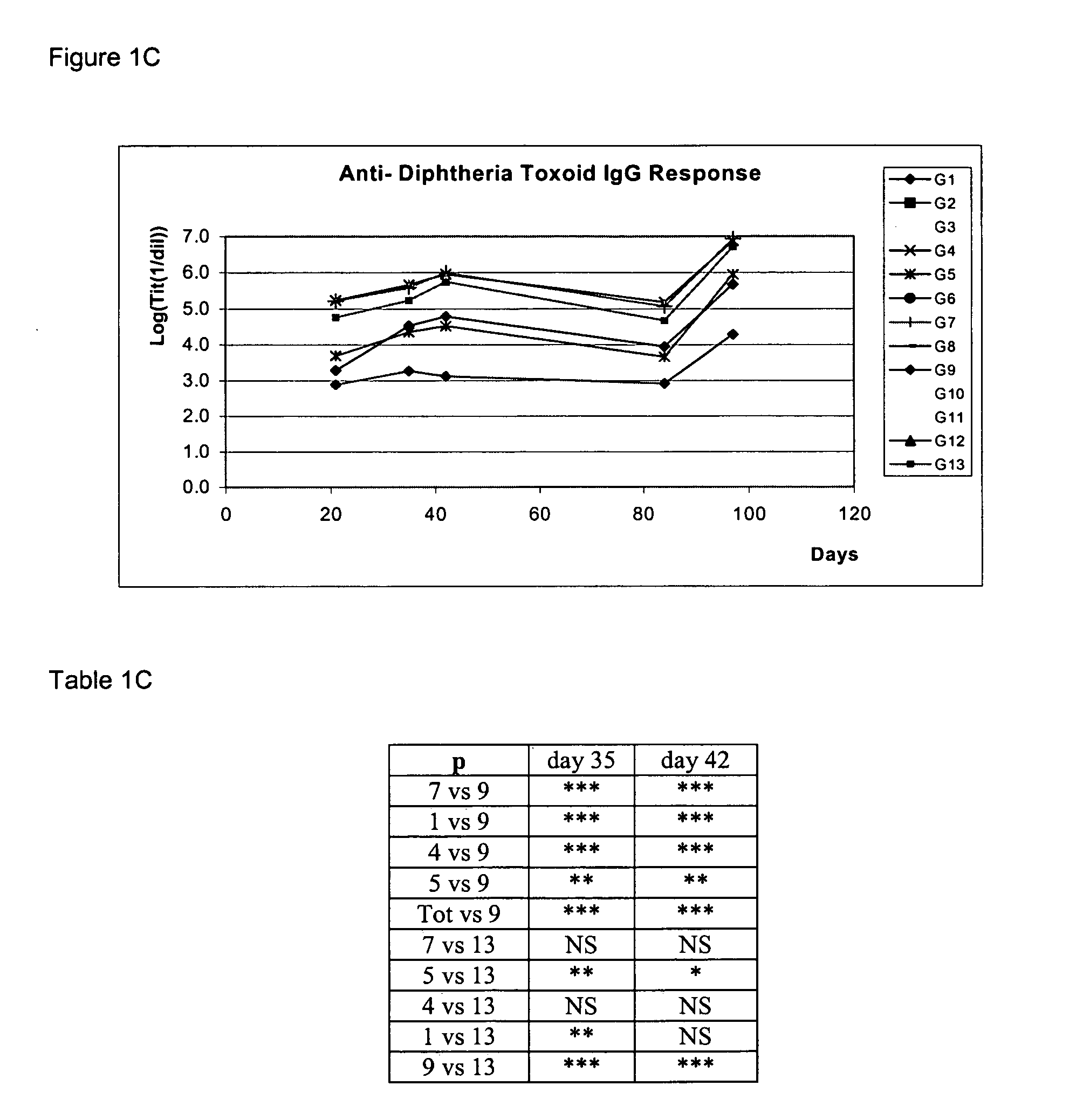Hepatitis b virus surface antigen as a mucosal immunostimulator and the resulting formulations
a technology of hepatitis b virus and surface antigen, which is applied in the direction of viral antigen ingredients, reverse transcribing dna viruses, biochemistry apparatus and processes, etc., can solve the problems of maternal antibodies that persist, inflammatory reactions in the lungs that could be potentially fatal, and intestinal lipases and bile salts that are destroyed
- Summary
- Abstract
- Description
- Claims
- Application Information
AI Technical Summary
Benefits of technology
Problems solved by technology
Method used
Image
Examples
example 1
With the aim of evaluating the antibody response generated after the nasal administration of several formulations containing different types of antigens together with or without HBsAg, an experiment was designed with 126 female BALB / c mice, 8 to 10 weeks of age, divided into 13 groups: groups 1 to 11 with 10 animals each, and groups 12 and 13 with 8 animals each. All mice were immunized at days 0, 14, 28 and 87 and bled at days—10, 21, 35, 42, 84 and 97.
The dose of each antigen administered per mouse is shown below:
GroupRouteDose of antigen per groupGroup 1:(nasal)15 μg of HBsAg + 10 μg of DTGroup 2:(nasal)5 μg of HBsAg + 3.2 UOP of Bp*Group 3:(nasal)5 μg of HBsAg + 10 μg of TTGroup 4:(nasal)5 μg of HBsAg + 10 μg of DT + 3.2 UOP of Bp*Group 5:(nasal)5 μg of HBsAg + 10 μg of DT + 10 μg of TTGroup 6:(nasal)5 μg of HBsAg + 3.2 UOP of Bp* + 10 μg of TTGroup 7:(nasal)5 μg of HBsAg + 10 μg of DT + 10 μg ofTT + 3.2 UOP of Bp*Group 8:(nasal)5 μg of HBsAgGroup 9:(nasal)10 μg of DTGroup ...
example 2
Determination of Mucosal Response of the Nasal Multivalent Formulations of HBsAg.
Taking into account that a stronger response to the nasally administered antigens depends on whether a strong response can be generated at the mucosal and systemic levels, we determined IgA antibody response in vaginal and lung ravages in the immunized groups that are described in example 1.
Vaginal Anti-HBsAg Response
After the fourth administration, on day 100, HBsAg-specific IgA response induced in vaginal lavages of the nasally immunized group with the tetravalent formulation, was not significantly different from that found in mice exclusively immunized with HBsAg through the same route. It is important to point out that at this time, serum anti-HBsAg IgG titers were not different either because of the strong response generated in the group immunized with HBsAg in PBS by boosting. However, a 20% higher seroconversion was found in the first group. Although no differences were found, it should be...
example 3
Comparison of Antibody Response Against the Proteins FHA and Pertussis Toxin After Nasal and Systemic Administrations of the Formulations of Groups 7 and 13 of Example 1.
Because of previous reports mentioned in the specification suggest a lower ability of the intranasal route in order to elicit a response against the individual proteins of Bp: FHA and pertussis toxin, the evaluation of the response against them was carried out in groups 7 and 13, corresponding to the tetravalent formulation administered by the nasal and parenteral routes, respectively. This evaluation was achieved after three and four inoculations. The statistical analysis of the response of the evaluated bleedings demonstrated there were no significant differences between the nasal groups and the parenteral ones. Therefore, we could conclude that in the nasal tetravalent formulation the induction continues even after the inoculation of a 2.5 times lower amount of Bp (FIG. 4).
PUM
| Property | Measurement | Unit |
|---|---|---|
| Mass | aaaaa | aaaaa |
| Mass | aaaaa | aaaaa |
| Volume | aaaaa | aaaaa |
Abstract
Description
Claims
Application Information
 Login to View More
Login to View More - R&D
- Intellectual Property
- Life Sciences
- Materials
- Tech Scout
- Unparalleled Data Quality
- Higher Quality Content
- 60% Fewer Hallucinations
Browse by: Latest US Patents, China's latest patents, Technical Efficacy Thesaurus, Application Domain, Technology Topic, Popular Technical Reports.
© 2025 PatSnap. All rights reserved.Legal|Privacy policy|Modern Slavery Act Transparency Statement|Sitemap|About US| Contact US: help@patsnap.com



